Estes Attack Craft Orion Plan
Estes - Attack Craft Orion {Kit} (1374) [1982-1984]
Contributed by Bill Eichelberger
| Construction Rating: | starstarstarstarstar |
| Flight Rating: | starstarstarstarstar |
| Overall Rating: | starstarstarstarstar |
| Published: | 2011-08-09 |
| Diameter: | 0.98 inches |
| Manufacturer: | Estes  |
| Style: | Futuristic/Exotic |
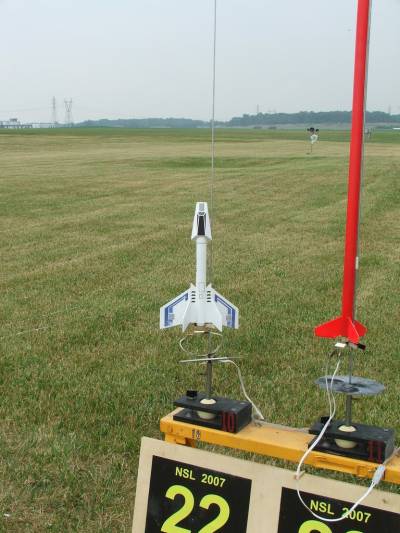 Brief
Brief
The Attack Craft Orion is one of the most unique early-80's designs and likely one of the more difficult cloning projects due to the seldom seen nose cone. I lucked out and won several of the cones in an Ebay auction, one of which I sent to Moldin' Oldies so that they could produce resin copies. It's not quite so difficult to find anymore.
Components
- BT-50H body tube
- PNC-50 cockpit style nose cone
- BT-20J engine tube
- AR-2050 centering rings (2)
- H-2 engine hook
- 3/32" balsa stock
- 24" length Kevlar shock cord anchor
- 36" length 1/8" sewing elastic shock cord
- 12" parachute
- medium snap swivel
Construction
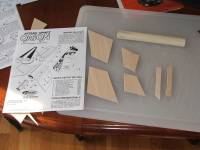 While not a difficult build, the Orion is an interesting one. The fins do not simply attach to the body tube in the standard 3fnc or 4fnc manner, but must be built up using multiple pieces before being attached. The first step is fairly simple, making sure that the vertical fins are glued onto the wing pieces at a 90 degree angle. The next step is slightly more
While not a difficult build, the Orion is an interesting one. The fins do not simply attach to the body tube in the standard 3fnc or 4fnc manner, but must be built up using multiple pieces before being attached. The first step is fairly simple, making sure that the vertical fins are glued onto the wing pieces at a 90 degree angle. The next step is slightly more 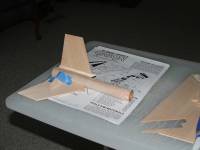 complicated in that it involves a fin joint guide to ensure the correct angle for attaching the main wing to the wing extensions. I cut out four of the guides so that I could attach two to each of the wing assemblies with masking tape and let the whole wing dry in one piece. This worked out nicely, but care must be taken so that the assembled wing doesn't dry to the guide, which isn't terribly aerodynamic. Aside from this, everything else is standard except for gluing the Kevlar shock cord to the motor mount, which should be standard at this point.
complicated in that it involves a fin joint guide to ensure the correct angle for attaching the main wing to the wing extensions. I cut out four of the guides so that I could attach two to each of the wing assemblies with masking tape and let the whole wing dry in one piece. This worked out nicely, but care must be taken so that the assembled wing doesn't dry to the guide, which isn't terribly aerodynamic. Aside from this, everything else is standard except for gluing the Kevlar shock cord to the motor mount, which should be standard at this point.
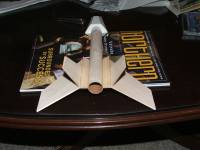
Finishing
I like birds that finish like this one. Two coats of Elmers Fill n Finish with sanding after each coat were followed by two coats of Valspar Primer, also sanded after each coat. Once tube spirals and balsa grain were gone, the whole rocket got two coats of Valspar gloss white. At that point all that was left was the decals, which was where I ran into trouble. I printed out a set of decals using the scan at YORP and some Bel Decal paper. They looked great when they were finished, and I sprayed them with a coat of clear before applying them to the rocket. The results were far from satisfactory. The decals stretched as they came off of the backing paper, and the ink began flaking from the decals as the slid into place on the rocket. The mess wiped off easily, but when the decals dried the white showed through in a lot of places, and in some spots the details were completely gone. This seemed to happen mostly to the blue areas, but some of the black also had problems. After seeing the pictures from the first flight at NSL, I realized that the rocket didn't even qualify under the ten foot rule, and began the process of removing the offending decals.
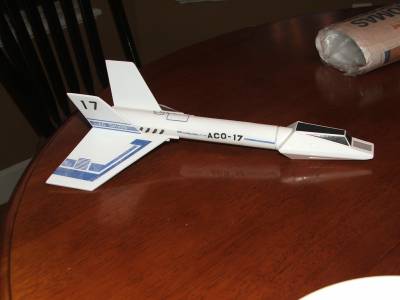
Flight
Beacuse of the unique look, the Orion is popular with spectators, something that I found out on the first flight. It was one of the rockets that I packed along for a NSL trip to Muncie in 2007. While I was prepping another rocket, a pre-school kid and his mom walked up. The kid was chattering excitedly about rockets and his mom was following nervously because of his tendency to want to touch everything he saw. He grabbed the Orion and she freaked, but he was handling it fairly gently and I assured her that it was okay. (I've found that clumsy middle-school aged kids with big butts were more dangerous.) In talking to the mom, I learned that they were just there as spectators and had nothing of their own to fly, so I asked if he wanted to see the Orion fly. The results were predictable and the chatter ramped up considerably. I asked mom if it would be okay if I let him come out to the pad with me to hook the rocket up. She was fine with it and I was surprised to find that the kid had another chatter gear. Impressive.
That all changed when we began to walk out to the pad. All around us were others with a dizzying variety of rockets, both big and small. Chatter mode ceased and the boy went into goggle mode, eyes wide and taking in everything near us at the pad with a whispered "Wow". We reached the pad and I was relieved to find that I'd not only remembered to attach a launch lug, but also had the ignitor and plug that would be needed. (Both are never assured when I take a rocket to the pad for the first flight.) I showed the future astronaut how to hook things up, double-checked my work, and delivered him back to his mom behind the flight line.
The flight itself was impressive. Having never flown a rocket with a fin setup like the A.C. Orion, I wasn't sure what to expect, but it performed admirably. A C6-5 was a no-brainer based on the size of the field and the Orion left the pad with authority. The rocket arced into the wind only slightly, making for a long recovery walk, but the flight was perfectly stable and ejection occurred just as it tipped over.
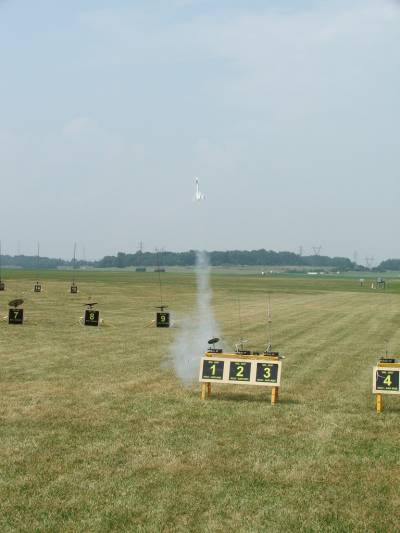
Flight #2 was a long time coming, and had an unfortunate ending. Chan Stevens and I met on a Saturday afternoon at former QUARK home, VOA Park. Chan had managed to launch several before I arrived and was ferrying another flyer back to his car on the other side of a mud bog when I finished up prepping the Orion. I noticed that he was talking to someone on the access road, but didn't give it much thought, and took the Orion to the pad with a B6-4 loaded. The flight was straight and would have been perfectly at home on B6-4 Field, ejecting just as the rocket stopped forward motion. The $.10 chute did what it was supposed to do, and I mentally marked the spot in the snow where the all white bird had landed, then went about disarming the launcher. I began stomping around the snow looking for the Orion, and it was beginning to dawn on me that finding it wasn't going to be all that easy as it blended in well with the field. Then I realized that I had company. A park ranger came up and began looking with me before telling me that he was going to tell me the same thing he'd just told Chan, that VOA was no longer friendly airspace and that we were decidedly unwelcome. I was kind of shocked, but realized that I had no cause to argue and went back to searching for the lost Orion, completely unwilling to let my last VOA flight be one that was lost within 100 feet of the pad. Luckily the ranger found it and brought it over to me. I thanked him for the assist and began wrapping the recovery works up when he asked if I had identification on me. "Unfortunately I'm going to have to write you a warning citation," he said, pulling out a ticket book. As it turned out, we were informed that we were being warned for flying rockets and causing damage to park property (when we drove through the mud bog, an add-on charge that was a bit ridiculous as neither Chan nor I planned to test out the ban.)
Recovery
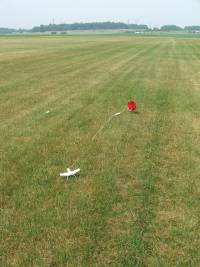 Summary
Summary
Pros: Styling. Performance.
Cons: None, but my decal making needs work.
 |
 |
Flights
 |
 |
Sponsored Ads
 |
 |
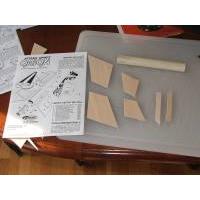
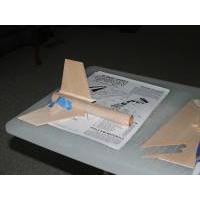
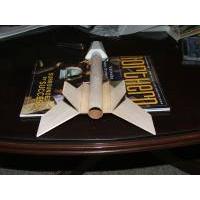
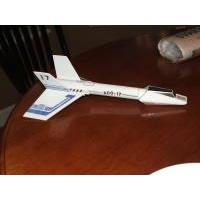
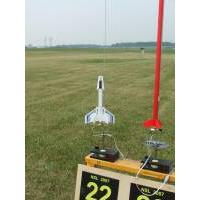
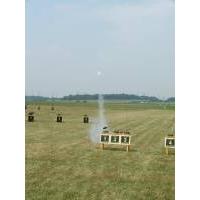
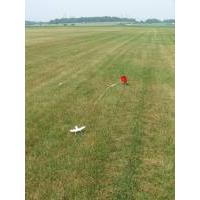












Kristian Holvoet (August 10, 2011)
I made one of those at summer camp in '83. I had forgotten all about it. Thanks for the trip down memory lane.